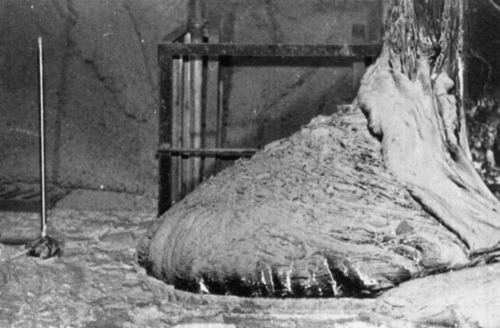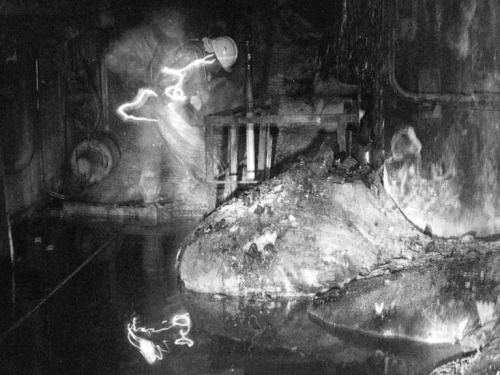Stubborn-turtle-blog

More Posts from Stubborn-turtle-blog and Others


One of the most dangerous pictures ever taken - Elephant’s Foot, Chernobyl. This is a photo of a now dead man next the ‘Elephant’ Foot’ at the Chernobyl power plant.
The image distortions in the photo are created by intense level of radiation almost beyond comprehension. There is no way the person in this photo and the person photographing him could have survived for any more that a few years after being there, even if they quickly ran in, took the photos and ran out again. This photo would be impossible to take today as the rates of radioactive decay are even more extreme now due to a failed military experiment to bomb the reactor core with neuron absorbers. The foot is made up of a small percentage of uranium with the bulk mostly melted sand, concrete and other materials which the molten corium turns into a kind of lava flow. In recent years, it has destroyed a robot which tried to approach it, and the last photos were taken via a mirror mounted to a pole held at the other end of the corridor for a few seconds. It is almost certainly the most dangerous and unstable creation made by humans. These are the effects of exposure: 30 seconds of exposure - dizziness and fatigue a week later 2 minutes of exposure - cells begin to hemorrhage (ruptured blood vessels) 4 minutes - vomiting, diarrhea, and fever 300 seconds - two days to live

The Milky Way over an ancient Bristlecone pine js
Something a little more frivolous
I have been all of these at one point or another.
Science Aesthetics
I was feeling inspired last night, so I decided to make this purely for fun.
To the moon and back: Cold, dark nights clutching thermos flasks of hot coffee. Machinery whirring as telescopes trace a star across the sky. Intricate, geometric drawings of the celestial sphere. A messy bun and a NASA t-shirt. Filling in the logbook while punk rock blares in the background to keep you energised and awake. Pictures of nebulae and galaxies everywhere, because pretty space pictures is half the fun. Annoyed huffs every time someone mentions their star sign.
Natural Philosopher: Long, intellectual debates in coffee shops about mathematics, physics, philosophy. Chalkboards covered with equations and calculations in a precise, curving handwriting. That Eureka moment while deep in thought, expressed only with a small smile and a scribbled proof on the back of a serviette. Chaotic desks in front of bookshelves groaning with old textbooks. Antique lab equipment as functional decor.
“Trust Me, I’m a Scientist”: Large computer screens running freshly-typed code. Neat lab books and PDFs of journal articles. The smell of whiteboard markers. Polished new equipment in a tangle of cables, hooked up to a digital oscilloscope. Exact amounts of chemicals in rows in metal shelves. Resting your feet up on the bench after a long day in the lab. The satisfying hum of your colleagues as they work on their experiments around you.
Science Expedition: Dirt under your nails and a loosely-bound collection of field notes. Plant clippings carefully taken to be analysed back in the lab. Soft fur on tough, wild animals. The bitter smoke from eco-friendly firewood while you roast marshmallows and listen to a supervisor’s witty stories. Free-handing diagrams while looking through a microscope. Sketching flowers and that gorgeous ocean view from your last field trip. Reading Darwin on the bus home but falling asleep on your lab partner’s shoulder out of sheer exhaustion after the first three pages.
Life is a Science: Scrolling past an anti-vax facebook post and resisting the urge to burn down the internet. Shiny dissection kits and the sharp smell of formaldehyde. Making time to work out and pack a healthy lunch because your mind is sharpest when your body is well. Debunking the latest superfood fad with peer-reviewed journal articles. Making friends with some of the nicer med school kids in anatomy class. Colour-coded, neatly labelled diagrams and a thousand different terms memorised. Getting a double-helix DNA sculpture for your desk.
What they show on TV isn’t real hacking: Rubbing your eyes after staring at a screen for five hours straight. Having a blank keyboard because all the letters are rubbed off already. Energy drinks in strange colours at strange hours. Being fluent in four different coding languages. Circuit boards and printouts. Ones and zeroes. Running jokes about turning everything off and on again. Rage-quitting when you realise you forgot a comma or a colon somewhere. Black screens with brightly coloured lines. The comforting click-click of fingertips tapping keys. Applying to intern at Google every three months because maybe they’ll take you this time. Writing a piece of code to do something simple just because.
Where is this, and what’s up with the white-washed parts of the towers?

Spring Mornings // Johannes Hoehn
50, 100 years down the line, will this be in the history books? Will the "War on terror" be over?

Battle of Mosul begins as forces push toward Islamic State stronghold.

Four regions with the same GDP
Such a cool apartment, I like the mini-window between the bedroom and sitting area.
Space Station Science: Biological Research

Each month, we highlight a different research topic on the International Space Station. In August, our focus is biological research. Learning how spaceflight affects living organisms will help us understand potential health risks related to humans on long duration missions, including our journey to Mars.

Cells, microbes, animals and plants are affected by microgravity, and studying the processes involved in adaptation to spaceflight increases our fundamental understanding of biological processes on Earth. Results on Earth from biological research in space include the development of new medications, improved agriculture, advancements in tissue engineering and regeneration, and more.
Take a look at a few of the biological research experiments performed on space station:
Biomolecule Sequencer

Living organisms contain DNA, and sequencing DNA is a powerful way to understand how they respond to changing environments. The Biomolecule Sequencer experiment hopes to demonstrate (for the first time) that DNA sequencing is feasible in an orbiting spacecraft. Why? A space-based DNA sequencer could identify microbes, diagnose diseases and understand crew member health, and potentially help detect DNA- based life elsewhere in the solar system.
Ant-stronauts

Yes, ant-stronauts…as in ants in space. These types of studies provide insights into how ants answer collective search problems. Watching how the colony adapts as a unit in the quest for resources in extreme environments, like space, provides data that can be used to build algorithms with varied applications. Understanding how ants search in different conditions could have applications for robotics.
TAGES

The TAGES experiment (Transgenic Arabidopsis Gene Expression System) looks to see how microgravity impacts the growth of plant roots. Fluorescent markers placed on the plant’s genes allow scientists to study root development of Arabidopsis (a cress plant) grown on the space station. Evidence shows that directional light in microgravity skews root growth to the right, rather than straight down from the light source. Root growth patters on station mimic that of plants grown at at 45% degree angle on Earth. Space flight appears to slow the rate of the plant’s early growth as well.
Heart Cells

Spaceflight can cause a suite of negative health effects, which become more problematic as crew members stay in orbit for long periods of time. Effects of Microgravity on Stem Cell-Derived Cardiomycytes (Heart Cells) studies the human heart, specifically how heart muscle tissue contracts, grows and changes in microgravity. Understanding how heart muscle cells change in space improves efforts for studying disease, screening drugs and conducting cell replacement therapy for future space missions.
Medaka Fish

Chew on these results…Jaw bones of Japanese Medaka fish in microgravity show decreased mineral density and increased volume of osteoclasts, cells that break down bone tissue. Results from this study improve our understanding of the mechanisms behind bone density and organ tissue changes in space.
These experiments, and many others, emphasize the importance of biological research on the space station. Understanding the potential health effects for crew members in microgravity will help us develop preventatives and countermeasures.
Make sure to follow us on Tumblr for your regular dose of space: http://nasa.tumblr.com
-
 onlyme-stuff liked this · 7 years ago
onlyme-stuff liked this · 7 years ago -
 meruemxxsxsxz liked this · 7 years ago
meruemxxsxsxz liked this · 7 years ago -
 rabunjelzzz-blog liked this · 7 years ago
rabunjelzzz-blog liked this · 7 years ago -
 mutluponcikko-blog liked this · 7 years ago
mutluponcikko-blog liked this · 7 years ago -
 emotitude reblogged this · 7 years ago
emotitude reblogged this · 7 years ago -
 ravenseyes12345 reblogged this · 7 years ago
ravenseyes12345 reblogged this · 7 years ago -
 antlrsblg reblogged this · 7 years ago
antlrsblg reblogged this · 7 years ago -
 partofmeiwillneversee reblogged this · 7 years ago
partofmeiwillneversee reblogged this · 7 years ago -
 starbe4m liked this · 7 years ago
starbe4m liked this · 7 years ago -
 lozmonaut reblogged this · 7 years ago
lozmonaut reblogged this · 7 years ago -
 susense reblogged this · 8 years ago
susense reblogged this · 8 years ago -
 sluttywesker reblogged this · 8 years ago
sluttywesker reblogged this · 8 years ago -
 cruellyinnocent reblogged this · 8 years ago
cruellyinnocent reblogged this · 8 years ago -
 meusolsticiodeinverno reblogged this · 8 years ago
meusolsticiodeinverno reblogged this · 8 years ago -
 meusolsticiodeinverno liked this · 8 years ago
meusolsticiodeinverno liked this · 8 years ago -
 the-sound-of-silence-dk reblogged this · 8 years ago
the-sound-of-silence-dk reblogged this · 8 years ago -
 loverphilosopher liked this · 8 years ago
loverphilosopher liked this · 8 years ago -
 blvckchvrn reblogged this · 8 years ago
blvckchvrn reblogged this · 8 years ago -
 scarecrow-16 liked this · 8 years ago
scarecrow-16 liked this · 8 years ago -
 itwasntmeitneverwas reblogged this · 8 years ago
itwasntmeitneverwas reblogged this · 8 years ago -
 merrittocrazy liked this · 8 years ago
merrittocrazy liked this · 8 years ago -
 tacitly-numb reblogged this · 8 years ago
tacitly-numb reblogged this · 8 years ago -
 meekrs reblogged this · 8 years ago
meekrs reblogged this · 8 years ago -
 lovero reblogged this · 8 years ago
lovero reblogged this · 8 years ago -
 literallyanythi liked this · 8 years ago
literallyanythi liked this · 8 years ago -
 dreadsinmyhead reblogged this · 8 years ago
dreadsinmyhead reblogged this · 8 years ago
Gaming, Science, History, Feminism, and all other manners of geekery. Also a lot of dance
243 posts
![It’s Amazing How Crafty Humans Are! [Via @veritablehokum]](https://64.media.tumblr.com/43311b965db92302465d25fa886954b7/tumblr_oj9ihcVr6D1s04h2ho1_1280.jpg)
